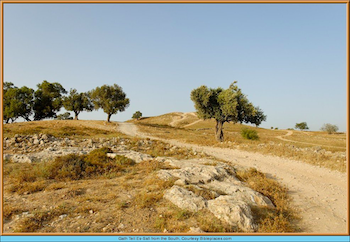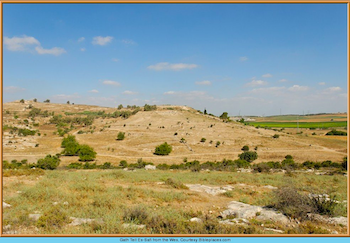By Aren M. Maeir
Director, The Tell es-Safi/Gath Archaeological Project The Martin (Szusz) Department of Land of Israel Studies and Archaeology Co-Director, Joint Bar-Ilan University/Weizmann Institute of Science Program in Archaeological Science (www.dig-gath.org)
September, 2008
Early Bronze Age (3rd mill. BCE):
In addition to excavating additional portions of the well-preserved late EB quarter on the eastern side of the tell (Area E), we can now say quite clearly that in addition to 2-3 EB III phases, there is an EB II presence in this area. Also, we excavated what may be the earliest known equid (probably a donkey) burial in the Levant, placed in a pit within one of the excavated buildings. Since we have uncovered several building complexes and an alleyway that separates them, we placed an emphasis on conducting a fine-tuned excavation, sieving all material with 1mm sieves, in an attempt to differentiate between the activities and waste found within the houses and in the alleyway. Importantly, we have now found evidence for the EB on the opposite side of the tell - in Area F, just below the MB fortifications. This further strengthens our understanding that Gath was a very large and important city during the EB (perhaps somewhat similar to the regional role of nearby Tel Yarmut). We may have found evidence of an EB fortification wall below the MB fortification, although this will be seen for sure only in further seasons. Unfortunately, while I had hoped that we would expose a portion of the EB fortifications in the new Area G, we appear to have uncovered a terrace wall only (whose date is not yet clear).

Middle Bronze Age (1st half of 2nd mill. BCE):
We continued to expose the MB fortification wall and associated glacis (sloping revetment), which may be based on an earlier EB fortification. From the pottery that was found in association with these features, we can say that there was activity on the site during the mid/late MB IIA and MB IIB/C. The finds included a wide assortment of local and imported pottery typical of this period, including “Tell el-Yahudiyeh Ware” and “Red, White and Blue Ware.”

Late Bronze Age (ca. 1500-1200 BCE):
We did not work in many LB contexts this season. Nevertheless, several noteworthy finds can be noted. In Area A and G, several interesting LB objects were found (in later contexts), such as figurines and imported Cypriote and Mycenaean pottery. In Area P, below the very interesting Iron I food storage area (see below), we have the remains of what appears to be a very large LB building, with rich LB pottery on its floors, possible evidence of the final stage of LB Gath (as found already in previous seasons in Area E).
Iron Age I (1200-1000 BCE):
Several interesting finds date to this period: In Area P, we uncovered parts of a large stone-built building (or maybe a casemate fortification?) which seems to have been used already during the LB, but was reused in the Iron Age I. On the floors of the Iron I level, we uncovered one, as well as a possible second, room with a rich layer of “phytoliths” (the non-organic skeletal parts of plants), evidence that the room was used for vegetal food storage during the Iron I. Associated with the phytoliths, we also found quite a lot of minute skeletal remains of rodents, who were clearly “feasting” on the foodstuffs in the room. This find is quite important since we have very few remains of food storage relating to the early Philistine culture. Hopefully, the finds from this context will shed important light on the foodways of the early Philistines (which we know are so different from the local Canaanites and Israelites). In Area A, we excavated mid/late Iron I remains, mostly courtyard deposits and garbage pits of the Iron I, with a rich collection of animal and fish bones, charred materials, pottery and other finds. These finds will also provide us with important evidence on the food habits of the Philistines, as well as other aspects of their daily life. In Area F, we have apparent evidence of two very early Iron I phases. One represents the earliest stage of the Philistine culture, the period in which the locally made Mycenaean IIIC pottery appears. In addition to showing quite clearly that this stage exists at Tell es-Safi/Gath, we may have found evidence of a plastered bath (or other, similar installation) which is reminiscent of similar features from Cyprus and the Aegean (from where the Philistines appear to have originated).
Iron Age IIA (1000-800 BCE):
We had several very important finds from this period. First of all, in Area A, we uncovered a clear level dating to the early Iron IIA, below the later phase of the Iron IIA that is dated to the late 9th century BCE and connected to the conquest of the site by Hazael of Aram (see below). In this earlier level, we uncovered a round Philistine pebbled hearth, perhaps the latest evidence so far of the continuation of this method of cooking in the Philistine culture (brought with them from their places of origin when they arrived in Canaan). In addition, and most importantly, in this level we found clear early Iron IIA pottery, a well-dated fragment of a seal impression (of the late 21st Dynasty in Egypt, ca. mid-10th cent BCE), and several nice clusters of carbonized grape pips. This latter find should be able to provide robust 14C datings for this phase. One cannot overemphasize the importance of the finds in this level, since it may provide the first concrete, well-dated (from several perspectives) context from the early Iron Age IIA in Philistia. In fact, the finds from this level may serve as a central key to solving the “hot debate” on the chronology of the Iron Age, raging for now for more than a decade. Hopefully, the 14C results will be available by late 2008.
The later phase of the Iron Age IIA was excavated in several areas on the site. In Area A, we continued excavating the Stratum A3 structure that was found last year in which a collection of cultic objects was discovered. Although we are far from understanding this structure, it is looking more and more like a cult-related structure, one that has a long history (pre-A3?). In Area D, in the lower city, we continued to expose impressive remains of this same stratum, the late 9th century BCE destruction of the site, which we relate to Hazael’s siege and conquest of Gath (see II Kings 12:17-18). Impressive remains of this destruction were found, including parts of several large structures, scores of vessels (including quite a few that were complete) and a selection of various other finds. Besides displaying evidence of this destruction, similar to that found previously in Area A, these finds demonstrate conclusively that our original assumption that the city of Gath was very large during the Iron Age IIA, reaching ca. 45-50 hectares in size, was correct. This makes it perhaps the largest site in Philistia, and perhaps in the entire Land of Israel during this period. As such, it appears to match the image of Gath that is portrayed in the biblical texts that relate to the early monarchy, in which the city is described as the largest and most important of five cities of the Philistine Pentapolis, the primus inter pares among the five cities. This serves as evidence that these biblical texts, even if completed and edited at much later stages, include distinctly preserved kernels of historical memory of the city and its role.
Finally, in Area F, on the top of the tell, evidence of this stage is emerging, beneath the late 8th-century BCE levels.
Iron Age IIB (late 8th century BCE):
While we previously found a late 8th-century BCE level in Area A, above the 9th-century destruction level, in Area F we now have two clear levels dating to the late 8th century BCE. Both levels appear to contain pottery similar to the Lachish, Stratum III horizon (which was destroyed by Sennacherib in 701 BCE) and appear to be oriented to the Judean culture. It would appear that these two levels mirror the post-Philistine history of Gath in the Iron Age. Apparently, after the Hazael destruction, the site was abondoned for awhile, and then resettled, for a short time, under Judean rule (as seen in the clearly Judean-oriented finds, such as the LMLK handles – typical features of the Royal Judean bureaucracy of the late 8th century BCE). These two levels may perhaps have been destroyed respectively by Sargon II and Sennacherib during their campaigns to the region. Interestingly, above the 9th century BCE destruction level and below these two Iron IIB levels, there is possible evidence of an earthquake discussion, which perhaps ties in with previous evidence (biblical and archaeological) of a major earthquake in the region in the mid-8th century BCE.
Crusader Period (12th century CE):
Additional portions of the very large Crusader period tower in Area F were discovered this year. This tower, part of the outer fortifications of the Crusader fort “Blanche Garde” had been uncovered in previous seasons, and this year we uncovered an additional section of it.
Other aspects:
In addition to the regular excavations, we had some very interesting additional activities on site. In particular, the work of the archaeological science team, members of the joint Bar-Ilan University/Weizmann Institute Program in Archaeological Science is to be noted. This work, directed by Drs. Steve Weiner, Elisabetta Boaretto and Ruth Shachak Gross, included several aspects: 1) A “decapage” (meticulous, horizontal excavation using methods usually seen in Prehistoric Archaeology) of a square in Area A, excavating part of the A3 destruction level. This excavating enabled a very fine-tuned analysis of the destruction and related finds and will hopefully assist us in understanding the processes connected to the destruction and the various functions carried out in this area. In particular the in-field laboratory (including an IR spectrometer in the field), which was supplemented by the additional laboratories back in the base camp, provided us with “on-line” results of these analyses - which enabled “real-time” understanding of the archaeological finds. This joint program is unparalleled at ANY excavation in Israel, and in fact, in the world. The close integration of a “regular” excavation team with a wide team of archaeological scientists IN THE FIELD, is simply unparalleled anywhere; 2) In addition, the archaeological science team conducted on-site analyses in the various excavation areas, providing important answers about the physical and chemical properties of various finds; 3) A very interesting program on experimental archaeology was conducted in relationship to this program. Shira Gur-Arieh, one of the project staff members, was in charge of an attempt to replicate and study the use of the Philistine rounded pebble hearths. Throughout the season, she carried out a wide range of experiments, attempting to recreate and understand, how exactly these hearths were used, and how they affected vessels that were placed on them.
